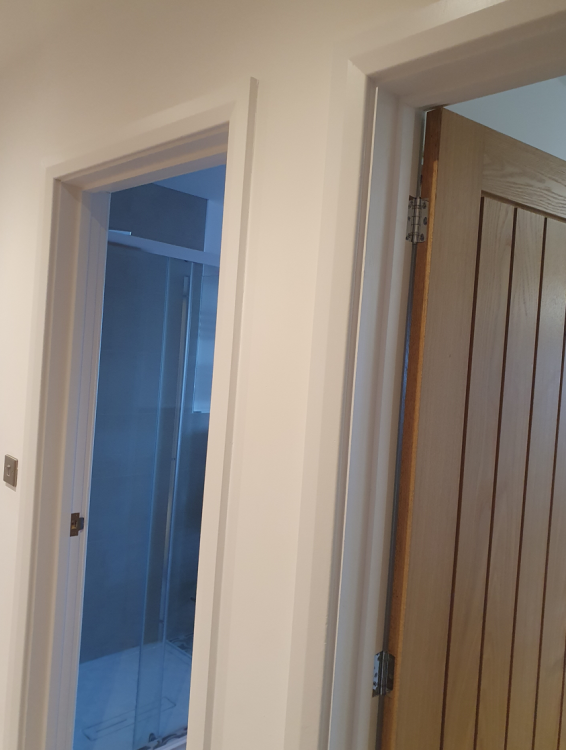Leaderboard
Popular Content
Showing content with the highest reputation on 02/01/24 in all areas
-
@Iceverge @Mr Punter @joth @ProDave Just thought I'd @ everyone who gave me a steer on this. Chatting to the builder and I obviously walked away from our first meeting with the complete wrong idea. He said that there shouldn't be any air/breeze at the sockets (I mistook him telling me about people who have come to him about this as an issue wondering if it was normal but he didn't do the builds). We covered a lot during that meeting so I misheard him on that one. I just asked a broad airtightness query and without needing any prompting he confirmed everything from you're posts/advice. He doesn't do the partel para fluid (said he could if I wanted but said it's serious money) and does sand cement as standard behind the IWI, he seals the chasing with sand cement (said though if I wanted to go with a painted sealing he'd happily do that either), seals the sockets, seals the conduits, for the first floor slabs he gets the ends filled but also goes on site during the install to supervise and has a membrane setup to wrap around the slab ends for airtightness exactly as @Mr Blobby showed from his construction in this post. I mentioned getting an airtightness test done once the airtightness work was completed and he welcome me doing this. Said it was best practice and had no issues with it. All in all, as much as it was a bit of a pain trying to get my head around this stuff (and realising I was weak link in this) it was great to have my own understanding of what's best and then music to my ears to hear the builder say exactly what you've all been saying. Good result, cheers for all the input.3 points
-
Yes all caulk should be paintable I used https://www.screwfix.com/p/no-nonsense-decorators-caulk-white-310ml/575683 points
-
I would say, any sun is bad, when heating is expected to be on - who cares about summer sun your heating is off.1 point
-
@dnb as I mentioned above I was one of the main contributors to the ESP-based NodeMCU-Firmware project which is a Lua based runtime environment that parallels MicroPython. I eventually did a JSH (long-time forum members will get the joke) and stopped contributing because I had an ME/CFS relapse at the time and the project commitments were just taking up too much time and effort that I didn't have the energy for. Anyway back to the point of this. Like Node.js, and NodeMCU Lua, the MicroPython runtime is single-threaded and event-driven in nature. Individual functions run single threaded to completion, so MicroPython makes poor use of the ESP32 multicores and the rich features set of the ESP32 RTOS. For Lua, a lot of the time critical driver code is interrupt driven at a H/W level. I suspect the MicroPython does more inside the Python runtime and hence has more jitters. Incidentally like Mike I've used dozens of high and low level languages in my time (I was even a contributor PHP for a bit, mainly working on Opcache); intellectually Python should be on the preferred ones, but there's something about it that I just don't get on with (I can lump C++ in there too). I like the simplicity and power of Lua, but it just doesn't have the programmer base. All my firmware and driver stuff is done in C still. I like Perl for QnD "hacking", and Javascript / node.js / Node-RED is my preferred platform for IoT and Home Automation.1 point
-
Triple glazing could be as low as 24mm 4/6/4/6/4 (commonly double of course), but it would vary from 36mm (4/12/4/12/4) but generally averaging 48/54mm.1 point
-
Additional ventilation through the gable walls should alleviate issue with moisture build up in the thatch/roof space. You lose the insulation from the thatch but you could more than make up for it in the ceiling. Agree a MVHR system would give additional assurance (and maybe clear out any residual asbestos fibre that have floated down).1 point
-
Good on you for having a punt. It's not easy and watching water pour away at 40⁰ is a tremendous waste of energy. I can see it being a solution for multi unit apartment with limits on the gas and electricity supply and no desire to install UVCs that require G3 sign offs. Ensuring the heat exchanger doesn't get clogged will be vital. With waxy soap compounds solidifying when cooled this could be a troublesome issue. For an individual bathroom in a house it'll be a hard sell. You can buy a well known electric shower for £70 and install it with basically a single pipe and cable.1 point
-
However caulk can remain flexible and wood (skirting etc) shrinks so cracking would still be a potential problem with epoxy 🤷♂️. CT1 has such a good reputation and £4 instead of £1 is not going to break the bank in the scheme of things.1 point
-
@Adsibob Don't rush into getting an installer yet until you figure out what you want and then crucially make sure you choose someone who knows what they are talking about and knows about low temperature heating and proper controls. @SimonD can I ask why you think he needs a buffer? it's quite unusual. It's my understanding that a LLH is installed to hydraulically seperate the circuits so a multi pump heating system can run at different flow rates without the pumps fighting against eachother. since he has only UFH in his house it seems to me the most efficient way of setting up his system would be to run two different flow temperatures one on hot water priority for the DHW and then the boiler at all other times providing flow direct to the UFH circuits. This would mean boiler always condensing 100% of the time in CH mode Is it possible he could even go as far as removing every mixing valve and pump from the manifold and running all off the boiler pump? this could of potentially been a much cheaper install with much less equipment needed.1 point
-
Right, as pointed out above, how is your heater more efficient. Shower waste water heat recovery has been around decades, you even get your SAP/EPC adjusted if fitted. What makes your WWHR better? Going to be a hard sell, 6lt/minute may be okay for a man, I suspect not many women will like a dribbling shower with that flow rate. If you really want to make an innovative product, think up a way to recover the energy when a bath is drained. More energy to recover from 100lt of 30⁰C bath water than 60lt of 26⁰C shower drain water. Have you got some actual usage data? We may sound a bit negative on here, but we like like a robust debate based on real data, not Hopium.1 point
-
Oh believe me, it really is. We're replacing the joists in the toilet, as that was similarly skilfully done. 3mm of the flush pipe pushed into the back of the toilet and at the cistern, the seals had been used but they'd been put in both backwards and inside out. Then had PTFE wrapped around the whole joint, over the outside of the clamp nut. On the plus side it has resulted in a good cushioning affect - sit down too heavily on the toilet and the entire floor gives to absorb the shock... My favourite so far is the 4Kg glass and brass light fitting in one room, suspended by 3 or 4 strands of the live and neutral wires. No earth fitted, the chain to hook it to a proper fixing tucked inside the cover. It fell off in my hands. Most of the lighting circuits have already been replaced, professionally by the look of it - when we took the ceilings down I found a 10m length of the original, no insulation left burnt to a crisp so I guess he'd done some work on that at some point and realised he maybe should get help when it started smoking... Hopefully explains why I'm not keen on disturbing too much until we absolutely have to and are in a position to do a permanent fix!1 point
-
They tend to be very efficient as well. Nearly all the energy goes into the water, and as it is used immediately, there are no standing losses. If you are in a hard water area, when it scales up, buy a new ten quid kettle.1 point
-
For heating you may want to look at some good threads on here for Air to Air Heat pumps- they have great COP and are DIY able (🤫). Electric shower and a unvented water heater under the kitchen sink. (if layout allows this to get to the bathroom). are the cheapest options. (But not cheaper than a kettle:))1 point
-
You can't really beat boiling a kettle for doing dishes. And then you can do it on the woodburner if you want. I've probably spent the majority of my life using this 'system' (and still do today, albeit on a boat).1 point
-
You can take the cosine of the incident angle and multiply that by an arbitrary length to get the new arbitrary length. Then divide the power by the length to see how much it reduces by. I may have to write it up proper sometimes instead of a quick reply. Or just go to PVGIS.1 point
-
One option I suppose is the stand alone hot water taps, the other maybe the small hot water units that can go under the worktop or on a wall?1 point
-
Froma slightly nerdy perspective, I have yet to find an Erp certificate for the Tado controllers. Erp of controllers is important because their functionality determines the overall energy efficiency of the boiler over 89% - therefore if you're installing a brand new system and need to provide 94% efficiency you haven't got the info, you can't actually provide that guarantee whereas with other controllers I've got the certificate to back up the install.1 point
-
We have 200mm slabs and the longest is 5.4 metres. The hollow core slab suppliers will provide a calculation report after measuring up the walls built up to first floor. Something to check when you start building, is keep an eye on the lintels over openings. If the opening is in a wall supporting the slabs then it may need to be beefier than lintels used elsewhere. Your architect/SE will supply you with a lintel schedule and there will be an assortment of lintels on site to choose from. Don't rely on the bricklayers to study the SE diagrams too closely. Same with padstones. Regarding SE costs, we paid only about 2K and our build is way more complex (architects 🙄) than I would choose if I were starting over again.1 point
-
10% is a little low, just had a look at my EPC and 20 to 25% is a better value for the increased heating requirements for DHW in the 6 winter months, as an average, compared to 6 summer months, as an average.1 point
-
1 point
-
This is so true, amount of times I've seen the nail skew out over the course of my build. I always keep a hacksaw blade close by.1 point
-
1 point
-
Just keep your hand away from where you nail. My second day, I held the wood close to where I was nailing, the nail hit a hard knot and went at 45 deg, through my finger. A tad sore, pulling my finger of the nail. Good job I had some masking tape in the van, to use as a plaster.1 point
-
Its a great sound, plus i love the smell of gas in the morning. 😃 Have good safe fun!1 point
-
Did it myself, just saw it as one of the simple jobs that I could do without needing to pay someone. I also saw it that £1500 buys a lot of plasterboard, or half the tiles for my ground floor, or even the 9 days I spent in the Canaries over Christmas.1 point
-
https://www.plumbarena.co.uk/product/mains-switch-rf-pump-overrun-switch-mainsswitch01/?gad_source=1&gclid=EAIaIQobChMIpfjJ6saIhAMV2pFQBh2YywwJEAQYAiABEgLPQ_D_BwE1 point
-
If that includes balancing and commissioning, and they are confident of not damaging your plaster work when they put the vent terminals in, that’s a pretty good price, at least for London. Which terminals are you going for? I’ve got cheap ones in my bathroom and kids bedrooms, expensive lindab airy ones elsewhere. Quite a big difference in audibility. Would recommend plumping for lindab airy if you can.1 point
-
Yes - I agree, I even advocated not doing this here I think, I won't be developing the hardware I will use COTS components everywhere I can, which I will double up on so I have spare of everything as I don't know how long even established brands will keep on keeping stuff available in a fast moving tech market, and document copiously both the system and the code if I need to develop any. I have wired the house traditionally and in places it will be used as such otherwise the switches just send momentary pulses, at 240V - so if needed be the momentary switches can be replaced by traditional rockers and the HA bridged out to control the lights, to the de-bounced inputs of the relevant PICO - its all node-red, local RPi install of mosquito and MYSQL for data logging - actually getting that stable has been one of the biggest challenges so far. DMX control of the lights via Whitewing will be the way forward although I have not purchased them yet as I don't actually know how many of the lights need dimming! I have struggled to keep it below 16 so I only need one unit but even then I will buy two with one as a spare! So I guess I would argue I have thought this through but I admit the risk you highlight but you must admit that any technology has a life (a carrying capacity) and so there are no guarantees anywhere here, only balances of risk.1 point
-
1 point
-
But isn't it just a repeat of part L, part O etc which have actual numbers in them? Now I think the LPA should use some measure of sustainability as a material factor in weighing up permissions. If they did, that would give an advantage to most self-builders over the mass-builders / minimum regs lot. In my limited experience, they don't at all though - there'll be guff in the local plan about 'sustainability' but the majority of new house permissions will be for low quality / minimum regs houses.1 point
-
@Adsibob no offence pal but just because something doesn't seem logical in your mind does not mean it doesn't work. plenty of people run heat pumps on boilers on pure weather compensation with no room influence at all. The only time you might have a bit of trouble is on mild days but anything can be over come. Your system is all UFH so it would be perfect for weather comp, the circuits are easy to balance on the manifolds simply provide more flow to the rooms that don't get as hot. Vaillant controls allow room influence and weather compensation at the same time which is what I use because sometimes when cooking in the open plan area it heats up a lot so it's good to have some room influence, you can do the same on Viessmann they have a stat for room influence, but using third party room stats is a mistake unless it's only as a high temperature limiter and not turning boiler on/off I think a good engineer could get you a 20% reduction in your yearly gas bill compared to the setup you have now. You spent a fortune doing up your house why settle for an outdated heating system that just 'works' Load compensation will allow your boiler to modulate down to the 1:19 ratio that it can and the burner will acheive longer burn times, some people I know with Viessmann can have single burns lasting hours. Longer burns and less cycling = constant condensing which means less gas usage, the house would also be more comfortable too. As someone mentioned previously without weather comp or load compensation your boiler is not currently doing what you think it's doing1 point
-
I actually agree that the planners require this, as at least it makes people think. The problem might be that planners are not technical people and don't necessarily understand the difference between the green-wash they are subjected to, and reality. So I agree that you try to find a previous successful write-up and adapt if to your circumstances. I'm especially pleased re water use. That is a big issue that is mostly being ignored but is sortable. Add sustainable drainage if that applies.1 point
-
I'm not sure if there are regulations that require you to do more than just replace the boiler. Grant still make External oil boilers. Price of the boiler alone on the Internet appears to r £1800 to $3500 is depending on size. She should get several quotes.1 point
-
Read up on how to make an old building airtight first, then the MVHR becomes simple, you may get away with dMVHR then.1 point
-
I'm kind of glad July hasn't been too warm, as its enabled me to get more done than i would have otherwise, but the rain has been the main issue, and surprisingly, hedgehogs which have been running all over the front garden, until they mysteriously all died, why i've no idea, felt very privileged having them here. First bit done whilst the hedgehogs were still around, the bit i've been wanting to do the most, around the boiler and gas box, where the worst damage to existing masonry was. June brought boiler service time of the year, so while the plumber was here, he fitted a new longer flue, and also a new gas pipe from the meter to the boiler, to accomodate the thicker walls. Around the flue, I have applied the required dual density rockwool wall board, heavy but really nice to work with, with the remainder done in the usual EPS. Fascia was also installed badly by a contractor many years ago, so i took the bad bits off to replace later on. Fascia repaired, brick slips applied and gas box has been resprayed and refitted. I still need to silicone around here and fit the boiler flue rubber, along with cutting the waste pipe down slightly to fit nice and snug. Rear of extension has been boarded, and mostly rendered, the top part is also fixed now, and just needs a render basecoat on, and brick slips. Front is also complete, and i have since popped a trim above the window to cover the foam, this also needs a bit of silicone when i get a tube. Below the DPC on all sections of EWI, i've got a tub of black render to finish this off, which i'm going to do all at once at the end. Really pleased i've managed to get this far, i've still got to take off 3 rows of tiles front and back of the original bungalow to put some mesh in to stop mice getting in the loft, ensure the insulation is bang on, and vented, replace the latts and felt and tiles back on, a nice autumn job i think when its a bit cooler still, minus the rain!!1 point
-
0 points
-
I seem to remember it is paintable as well. @Pocster is the CT1 man, we all told him that it will fix everything. As I drove on the M25 yesterday, between the M40 and M4, there is a very large electronic sign advertising CT1. Must be there to remind all the Boing engineers it is used to stick the doors on.0 points
-
I like the description of the pipework "honestly like they got a delivery of copper pipes thrown in a cupboard and just decided to connect them up wherever they fell. " Brilliant That waste fitting is all kinds of spezial - good luck because if that's what the previous home owners plumbing skills were like the house is going to be the gift just keep giving!!!0 points















